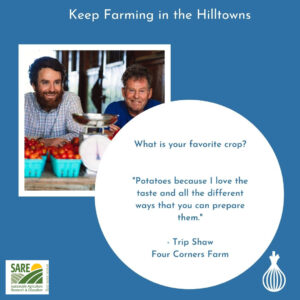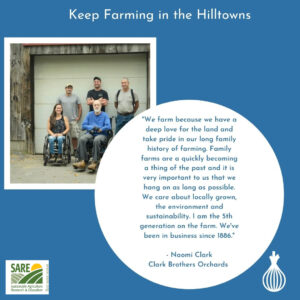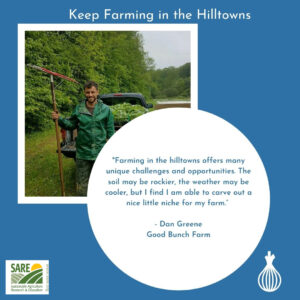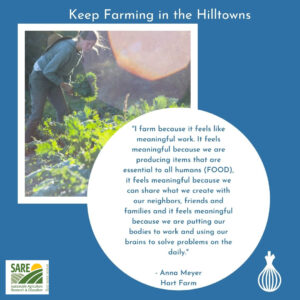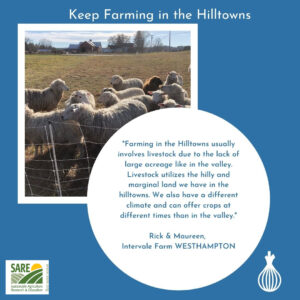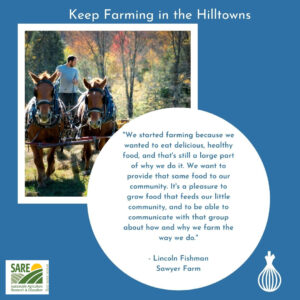Final report for ONE20-357
Project Information
The Hilltowns of Western Massachusetts consists of roughly 600 square miles of sparsely populated land, consisting of 20 communities and spanning 3 counties. Folks that live here must drive at least 30 minutes to get to the nearest grocery stores and our rural growers are driving to those same centers to sell their goods. We have been searching for a way to build a viable rural market structure that not only improves food access but also shrinks the transportation burden for farmers.
We originally set out to develop the Hilltown Mobile Market, a traveling free choice farm stand that aggregated produce from 6 farms and delivered to 4 locations. This business model had some problems such as our ability to prognosticate what items “customers” will want to purchase and in what quantities. Additionally in an area that's so vast and also lacks public transportation, having 4 stops did little to increase access to local foods. As of the 2021 season we had reached our capacity with this model, 120 free choice share members.
With a change in management and after much thought we have once again made an adjustment for the 2022 season and decided to move the market onto an online ordering platform, no longer trying to predict what customers want. Additionally, we have partnered with local businesses, which offer 5-hour pick-up windows utilizing their infrastructure, throughout the region. We now serve 350 plus customers, work with 18 farms and offer 18 pick-up locations throughout 11 communities. As we work to determine the best way to make the market sustainable it seems like we are on the right path.
This project seeks to develop and make operational an innovative rural food delivery service that utilizes an online ordering platform which allows farmers to list there own products at their own prices and reach a larger audience. This online market place would compliment an already existing subsidized Mobile Market that has been working to overcome the pricing and transportation barriers when accessing local food in our rural region.
A second objective is to enhance the existing Mobile Market so that subsidized and unsubsidized shares will sell from one venue seamlessly, taking the stigma out of subsidized markets and make fresh local food available for all in the community.
A third objective will be to build sustainability into the Mobile Market while increasing the income for our farm partners as a result of increasing the volume of this outlet.
Finally we hope to increase the presence of real food at our neighborhood convenience stores. By selling items by the piece to these locations the owners will be able to build up demand for these products with a minimal monetary investment.
The problem facing our rural Hilltown growers is the severe staffing challenges that come from lacking a seasonal, skilled agricultural workforce. The small grower must do almost everything on their own and this makes the administrative work of the farm share model prohibitive to many. The farms in our area have all gone away from the CSA model because of the burden of marketing shares, communicating with shareholders, tracking payments, and scheduling pickups. Because of their scale, they also prefer direct sales rather than wholesale accounts. This leaves them vulnerable with only farmers markets and unmanned farm stands as access points to their customers.
The solution we came up with is for them to work cooperatively to share customers and administrative costs by creating an online hyper local marketplace that will be distributed by our Mobile Market team. This model aggregates produce, dairy, meat, and eggs from 18 farms and sells them utilizing an online platform to a customer base of over 350 people. The farms list their products and set the inventory amounts as well as their own price by Friday night. Our market opens Saturday and runs until Tuesday at 1 pm. Pick sheets are sent to the producers by 3 pm Tuesday afternoon, we set out to pick-up the products from the farms Wednesday morning. Wednesday afternoon/evening our staff of 4 sorts and packs all the orders and stores them for delivery on Thursday and Friday.
With this model we have been able to expand the variety of offerings for the consumer. By establishing price floors, our farms are not racing to the bottom and are setting fair prices that represent the work they have done. In an attempt to start transitioning away from the market's reliance on grants we have decided that we need to tack on an additional 25% to allow for us to start having revenue coming in (we will reevaluate this structure after this season). As the 2022 season is underway, the farmers are ecstatic as demand has increased and some are selling a substantial amount of goods without having to leave the farm. Overall the customers seem equally as happy, many choosing to do all their grocery shopping on our platform due to convenience.
By solving one of the challenges of staying small-scale, our partner farms can continue to put soil health and sustainable practices first while resisting outside pressures to grow their businesses to the point where they compromise existing practices such as no till, horse-powered soil preparation, hand picking and other low-tech, high-touch practices.
Benefits for producers which make this the right solution include those outlined in Local Harvest: A Multi-farm CSA Handbook, pages 23-30, guaranteed market, direct link, control over pricing, specialized crop production, convenience, low-risk participation for new and small growers, community building among growers and safety net.
We identified this need by meetings, brainstorming, and refining ideas. This project was developed by the producers named in the project over a series of facilitated winter meetings looking at which cooperative programs would best help their business at this time. Other potential projects were discussed, but this rose to the top for three reasons:
- Feasible within a year.
- Fits with the existing Mobile Market, but expands it to also serve farmer’s needs.
- It has the potential to promote a local food system with more local control (especially relevant with the current economic and supply chain disruptions).
Cooperators
- - Producer
- - Producer
- - Producer
- - Producer
- - Producer
- - Producer
Research
2021 Annual Report of Activities **Old Management**
Completed Activities - September 2021-December 31, 2021:
Staff Roles Planning: October/November 2021 - Mobile Market team meetings to recap season, review consumer surveys and plan for winter crop planning with producers, including farmer survey on 2021 season
Local Food Marketplace: This past year, we switched into an online ordering module, called Local Food Marketplace, which assisted us in placing orders for the market, due to its automated functionality. Farmers were asked to update their “marketplace” with crop availability and pricing, weekly. This allowed the market manager to place orders from one platform based on trends, while shrinking staff hours associated with calling farms, like we have done in the past. We understand the importance of this platform and in an effort to minimize food waste and maximize customer satisfaction and we will be opening this digital marketplace to CSA members for the 2022 season.
Pre-season crop planning -through a series of steps, the Mobile Market staff are finalizing crop planning with the farms to be strategic about what each farm will supply to the aggregated farm share. This improves efficiency when each farm supplies a streamlined amount of items - while variety for the consumer is maintained or improved. We began with a producers surveys in November, followed by some produce estimations by the staff based on projected share numbers, and are currently finalizing a spreadsheet across farms by product.
Pickup and Delivery logistics planning – With our partners at Healthy Hampshire, the Hilltown Food Council and the farmers, we are finalizing growth plans for 2022. Both number of shares and number of delivery locations can be potentially increased. This is based on the how much the farmers can produce, the capacity of the van and sales projections. In addition, staffing the market was challenging this year with national labor shortages and may be a factor in expansion plans for 2022. As we sold out the available shares within weeks and we did not tap the farms existing customer contact lists (ie from their previous csa buyers), we feel the market is very strong for growth, and that capacity of the van and finding staff will be the limiting factors.
Share signups - will take place May-July 2022
2022 Annual Report of Activities **New Management**
Activities 1/1/22-8/31/22:
We increased our usage of Local Food Marketplace (online ordering platform) and shifted the in-person “market” towards a pre-order system. This allowed us to diversify the products we carried while increasing the number of farmers that participated in the marketplace. Since customers must now order the products they want prior to receiving them, it became possible to carry meat, eggs, dairy products, and other value-added products, in addition to the vegetables and fruits we have offered in past years.
Identified central locations for distribution. Now that products were pre-ordered the challenges of prognosticating what customers are going to purchase has been removed and this has allowed us the chance to increase our distribution locations. In past years we were only capable of offering 4 locations that hosted in person 2-hour markets that were free choice. For this upcoming season we have cultivated relationships with local businesses and by utilizing their infrastructure we are now offering 5-hour pick up windows at 18 locations spread throughout the hills, still free choice but pre-ordered.
Since we live in a rural area that has only recently gotten high-speed internet, we have heard apprehensions about ordering online from some customers. To ease their fear, we have offered in-person trainings and on-boarding help, which has allowed us to demystify technology while showing the advantages to many of our returning customers. If customers choose to not use the online platform, we have also decided to offer a "Farmer's Choice" box, that brings a monthly, biweekly, or weekly box of locally produced goods to the customer. We found this was helpful in boosting the sales of farms that were below the median sales for that week.
We have increased participation in the market this year, despite the switch to an online platform. Growing from five to 20 farms and improving on the previous year’s customer growth we have increased from 120 customers to 350. We have also jumped fully into wholesale delivery for restaurants and corner stores throughout the Hilltowns. This not only increases outlets for our rural growers but now also allows these businesses to slowly incorporate local produce into their business as they build up demand.
The market this season looks radically different than the one of years past, but it seems to be the first step towards the self-sufficiency goal that we have been seeking to obtain since our inception. After listening to customers and growers’ input from surveys it feels like we have found a way to meet all their requests: market diversity, more locations, increased purchasing and cultivating community connections.
We have also found ways to accept alternative payments, since Local Food Marketplace does not allow for online processing. We offer 4 in person “markets” a week that allow customers to utilize WIC and Senior Coupons as well as the in-person processing of SNAP/HIP benefits. While considering the transportation barrier faced by many of our seniors around the Hilltowns, this streamlined approach has allowed us to also find the time and space to offer door delivery for seniors living in subsidized housing units. We will find a way to expand this door delivery service next year, as we do not see that need shrinking.
Share signups – We have increased shares from 120 to 350, not including the 68 seniors we fund-raised and purchased shares for.
Components:
Vehicle: Maximizing the space and route of the vehicle to increase volume continues to be a focus of the winter planning work. We ended up having to rent a second refrigerated box truck for this season. One vehicle does the in-person market stops and processes the payments, 4 stops per week. The other vehicle covers distribution to pick-up locations (14 stops per week), senior door delivery, and wholesale delivery.
Farm partners: Off-season planning takes place Nov-Feb on the three main issues of crop planning, pick up and delivery logistics and branding and marketing for the cooperative farm shares. As of 2/17/22 we have held our farm meetings, agreed on a strategy for the up-coming season and also increased the number of participating farms in these conversations, 18 farms participating in 2022. All of which have been trained and feel comfortable utilizing the online marketplace.
Engagement Strategy:
Keep Farming in the Hilltowns is in its 8th year of engaging local farmers in meetings and with small business assistance to promote food and farming in the Hilltowns. This is the fourth year for facilitated winter meetings to share best practices, news and to explore programmatic ideas, but the third year in which we are focusing primarily on building out the cooperative market concept. Since our producers who supply the market have become our primary focus, we need to keep in mind ways to support other small farmers in our community and onboard any new supplies to the market in the future.
Through another grant we have been able to also offer technical assistance to our rural producers. We have been able to help with soil sample tests, off-grid irrigation techniques, revitalization of apple orchards, and other marketing, website, newsletter support. A part of this program we intend to build up as well.
The Hilltown Food Council is the consumer advisory council to the Hilltown Mobile Market and continues to be a format which we use to engage our customers on their preferences and needs in terms of local food access. At the January meeting we reviewed shareholder and customer feedback from the 2021 Mobile Market. As of 7/12/22 we have had our final meeting with the Food Council to troubleshoot any lingering issues before the market opens. Over-all the group supports this online transition, as we reminded them our main focus is economic development for farmers and increasing access to real food. This was the best method to increase food access for many Hilltown residents despite the lack of public transportation.
Hilltown Cooperative Farm Share
Data for survey was collected online from November 2021 through December 2021, two farms did not respond despite repeated efforts to engage. Despite a year of solid sales growth in 2021, the producers have mixed feelings on the success of the program from their perspective. See further discussion under Research Conclusions.
Farmer-Survey-Responses-SARE
Customer Survey:
Overall customers were happy with their experience but they are hoping for more product diversity and ability to order online for the next season. See further discussion under Research Conclusions.
CustomerSurvey21-1
The 2021 and 2022 seasons have been managed by two different people.
This is why the two years look so radically different. By paying attention to customer, farmer, and staff feedback from the 2021 season we were able to come up with a new solution that builds upon the foundations of the market that have been built by my predecessor. Even our objectives have shifted slightly, and we have reached them.
We have developed a successful online marketplace, that is supported and utilized by both customers and farmers, and this has reduced our administrative costs. With a click of a button we can run reports, understand purchasing trends, make payments to producers and process payments, this has drastically reduced the amount of time our staff spends with book keeping.
Most subsidized (either by the community or government) and unsubsidized shares are purchased online and picked up at our locations without anyone knowing how the order was paid for. Customers that have signed up for a SNAP/HIP Share automatically get a spend down balance attached to their user account and can order eligible items and get them delivered to any location they want. However the platform we are using this season does not allow us to process SNAP/HIP cards online, so if a customer wants to add extra items or did not sign up for a share they must go to one of our in person distribution locations, to have their card physically swiped. As this doesn't help with reducing stigma or making these purchases easier, we plan on finding a new online marketplace platform for next year.
We are moving towards building sustainability into the market. In past years due to grant subsidies we were purchasing produce and often selling it at cost or at a loss. More concerned with fulfilling the CSA style shares, and this gave a false sense to what the true cost of food actually is. This season we are marking items up, since this was the first year of this version of the market we decided that the consumer will cover the increase, as we wanted to build confidence with the farmers. After this season is over we will reevaluate this mark-up, the technique we feel the most comfortable with utilizing is splitting the cost between farmer and consumer. Another way we are building up sustainability is by offering wholesale ordering, this has been established by Farm Fresh Rhode Island (CNE09-058) and we do not see a need to reinvent the wheel.
As we build up wholesale we are starting to see the presence of real food in our corner stores! By offering no minimum for delivery, these small businesses have been able to order a few pieces at a time as they build up customer demand.
2022 Data will be collected at the end of the season in late November. Surveys will look similar to the one from last year, however we will also be reaching out to non-repeat customers to find out if the online transition is the reason.
We used the above surveys as a planning tool for the cooperative 2022 farm share.
Despite a year of solid sales growth in 2021, the producers have mixed feelings on the success of the program from their perspective. An extremely wet summer ruined many crops and we were not able to follow our crop planning agreement as closely as we all would of like, frequently substituting produce from one farm with produce from another. This led to some farmers revenue being less than expected due to crop losses.
The new ordering software system, Local Food Marketplace, got good reviews, but with producers admitting they did not use it efficiently to enter in crop availability for the coordinator to order. We have addressed this situation, offered training and most farms are comfortable using this for the upcoming season.
Repeating patterns in the surveys have led us to reevaluate how we will run the market in 2022. Customers want diversity in products and would like to see an addition of dairy, eggs, and meat into the market. Farmers would like to offer all their specialty products. With this information in hand, we shifted the market into an online ordering platform. This will allow customers to select what goes into their CSA share in advance, allow more farms to be involved and offer specialty or value added products that were excluded in previous years.
Overall customer participation and the amount of product the farms are now moving, leads us to believe this program is a success. Now that we have a model that is infinitely scalable we can shift focus into learning at what volume level the Mobile Market becomes self sustaining, our Mobile Market program costs about $65,000 a year to run.
Additionally, on a personal level it does my heart good to finally see fresh food in some of the Hilltown corner stores.
The customer participation in the market for the 2022 season has been mind-blowing. We are only 4 weeks into the market and on track to shattering the revenue record set last season. As we continue on our staff has become more comfortable with the packing and distribution process which has led to increased efficiency. Our Mobile Market has made several changes in its short life but finally seems to be heading in the right direction.
Education & Outreach Activities and Participation Summary
Participation Summary:
2021:
Farm Tours - After the first three scheduled were rained out, the summer tours were postponed for the duration of the season
Hilltown Food Council - met monthly over the year. Summary of work above.
"Meet your Farmer" outreach materials available at the market - posters, coupons, handouts and coordinated social media campaign all highlighted one of our producers each week of the market in a strategic attempt to encourage mobile market customers to become regular patrons of the producers farm stands. Anecdotally heard of a few customers trying a farm stand they hadn't been to before, but no statistical evidence that this was successful enough to repeat in the same format for 2022.
2022:
Involvement with the Hilltown Food Council continues.
We have been working with the Amherst Mobile Market to help solve some of their distribution issues.
Also the creation of a Hampshire County Food Policy Council: Food Distribution Circle has allowed us to work with our peers in Western Massachusetts to troubleshoot regional distribution and supply issues.
Finally we have been working with a farmer run collective on Cape Cod to build a Mobile Market/Food Distribution program.
If anyone has thoughts, ideas, questions, please reach out!
Learning Outcomes
The repeat farmers had low expectations for sales through the Mobile Market due to the last couple years of trying to grow the project. I have heard the shock from some of these producers when they sell out of listed produce in a few hours of the online-market opening. This has led some of these farms to reevaluate their fall plantings in anticipation of the market running through November. Additionally whole-sale pricing was something that many of the farms did not seem to understand and after a little guidance they are now moving volumes of product to local businesses.
Two of the repeat farms have also dropped out of farmer's markets for this season since they are getting the same value for their products through the Mobile Market without having to take a 45 minute commute to get to market.
It appears that farmers are happy with the market transition, and despite it being early in the season some farms are already coming close to their yearly totals for last season. As this relationship grows between our staff, the farmers and customers, I am optimistic about what this program is capable of.
Project Outcomes
Farmers have noticed an increase in sales, and will be thinking about the Market as an outlet when planting fall crops and planning for the 2023 season. Some of the new farms we are working with are in their first year of production and are over the moon with the sales and the social media publicity they are getting. We have also built a strong network of Hilltown producers, where the farmers visit each others fields, help troubleshoot issues and purchase materials in bulk.
We will not be able to see the full value of this project until we receive the surveys back in December, but there feels like some real change is happening in our rural food system.
This is my first season with the Mobile Market, my predecessor ran the market since its inception. With this transition, this is also the first year where we are running the Mobile Market like an actual business, we are working to develop a model that will allow the market to be self sustaining. By critically looking at the markets structure I was able to find the bottlenecks and through collaboration with the market staff we have hopefully overcome them. We have shifted from the 4 free choice in person markets to an online ordering platform offering 20 pickup locations, simultaneously increasing our customer base and farmer participation. We plan to keep the market steering the course until we have enough data to see if this model could actually be profitable.
Projecting this out into future years, I believe it would be beneficial to build up the collaborative farm mentality. We have many small producers creating the same products, competing for the same markets and this creates a race to the bottom for pricing. By banding together, the rural farmers of the Hilltowns have the potential to increase sales by minimizing the competition between themselves. Idealistic sounding for sure but defiantly worth attempting to develop.
